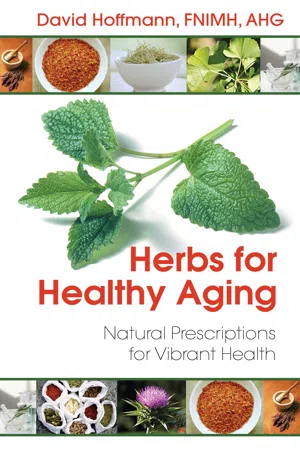
- 384 pages
- English
- ePUB (mobile friendly)
- Available on iOS & Android
About This Book
A guide to herbal remedies that promote longevity, restore the body's systems, treat chronic conditions, and maintain natural health • Offers herbal remedies for many conditions associated with aging, such as prostate enlargement, hot flashes, hypertension, insomnia, and arthritis • Provides herbal treatments to restore and maintain function in each of the body's major systems • Explores more than 150 herbs and their actions on the body and mind, preparation methods, and recommended dosages In this herbal guide to healthy aging, medical herbalist David Hoffmann discusses how to maintain the body's vitality as we age and how to treat and prevent the health concerns brought about by aging. He provides herbal treatments to restore and protect each of the body's major systems--from the muscles, bones, and digestive system to the pulmonary, cardiovascular, and reproductive organs--as well as herbal remedies for specific ailments such as prostate enlargement, hot flashes, hypertension, insomnia, bronchitis, varicose veins, and arthritis. He shows how herbs can help minimize dependence on conventional medical treatments and provide a safe and welcome alternative to the unpleasant and sometimes dangerous side effects of synthetic drugs. In the materia medica, Hoffmann details more than 150 health-promoting herbs and their actions on the body and mind, preparation methods, and recommended dosages. This authoritative guide to herbal preventive medicine offers holistic treatments designed not only to promote vibrant health but also to provide a way to age with grace.
Frequently asked questions
Information
- As the food is chewed saliva mixes with it, initiating the digestion of starches.
- Once swallowed, the food moves down the esophagus, a tube that leads from the base of the tongue to the stomach.
- In the stomach the food is physically broken down further by the stomach’s churning action, and chemically digested to produce a thick liquid mixture called chyme.
- The chyme passes into the duodenum, the upper portion of the small intestine. As the chyme is moved through the intestine by muscle contractions (peristalsis), intestinal juices, pancreatic juices, and bile complete the enzyme-facilitated breakdown of the food. The nutrients released by this process are absorbed through the walls of the small intestine and enter the bloodstream to be distributed around the body.
- Undigested material moves into the large intestine, or colon, where the water is absorbed back into the body.
- The remaining material passes into the rectum, whence it is eliminated.
- The salivary glands produce less saliva with a lower concentration of digestive enzymes.
- In the stomach, production of gastric juices declines starting at age twenty. In the middle years there is increased incidence of chronic inflammation of the stomach with associated degeneration of the mucous lining. Such changes can prevent an older body from absorbing as much iron and vitamin B12 as a younger one can absorb.
- One age-related intestinal change that does bother some people is increased intolerance of milk products, as over time the enzyme that breaks down milk sugar (lactose) disappears from the intestinal tract.
- The liver experiences age-related changes, including reduction of enzyme concentrations.
- The pancreas also shows age-related changes in the making and secretion of digestive enzymes.
- Food takes longer to make its way down the esophagus because of a decrease in the wavelike motion that pushes the food toward the stomach.
- Food may take longer to travel through the small intestines.
- There is more opportunity for water to be absorbed from the feces, increasing the chance of constipation.
Table of contents
- Cover Image
- Title Page
- Epigraph
- Dedication & Acknowledgments
- Table of Contents
- Foreword
- Introduction
- Chapter 1: The Digestive System
- Chapter 2: The Cardiovascular System
- Chapter 3: The Pulmonary System
- Chapter 4: The Upper Respiratory System
- Chapter 5: The Nervous System
- Chapter 6: The Urinary System
- Chapter 7: The Reproductive System
- Chapter 8: The Musculoskeletal System
- Chapter 9: The Skin and Hair
- Chapter 10: The Immune System
- Chapter 11: The Endocrine System
- Chapter 12: Herbal Medicine Making
- Chapter 13: Materia Medica
- Footnotes
- Useful Internet Resources
- Bibliography
- About the Author
- About Inner Traditions • Bear & Company
- Copyright & Permissions
- Index